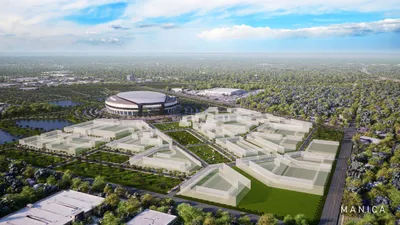Introduction
The Chicago real estate market 2025 presents a fascinating paradox: buyers hold unprecedented negotiating power, yet many remain hesitant to act. You’re witnessing a market transformation that’s creating opportunities for those who understand the shifting dynamics.
Will The Chicago Real Estate Market Collapse? This question keeps both buyers and sellers awake at night. The short answer: no collapse is imminent, but significant adjustments are underway. The market is experiencing a recalibration rather than a crash, with housing market trends Chicago pointing toward a buyer-favorable environment that hasn’t been this pronounced in over a decade.
Right now, you’re looking at a market where 89% of sellers have reduced their asking prices, buyer activity has hit near-decade lows, and mortgage rates hovering around 6.17% continue to influence purchase decisions. These aren’t signs of disaster—they’re indicators of a market finding its new equilibrium.
The highlights of Chicago’s evolving real estate landscape you’ll discover:
- Current market statistics and how Chicago compares to national trends
- Specific strategies buyers are using to overcome affordability challenges
- Why sellers need to adjust their expectations and pricing strategies
- Expert forecasts for where the market is heading in the coming months
Whether you’re planning to buy, sell, or simply stay informed, understanding these trends will position you to make confident decisions in Chicago’s transitioning market.
Current State of the Chicago Real Estate Market
The Chicago housing market in 2025 presents a distinct landscape shaped by shifting dynamics between buyers and sellers. If you’re searching for houses for sale Chicago or looking to buy house in chicago, understanding these current metrics will help you navigate your decisions more effectively.
Key Market Statistics
The median home value Chicago currently sits within a broader national context where the typical U.S. home is valued at $364,000 according to Zillow’s Home Value Index, which has remained relatively flat year-over-year. Homes are spending approximately 27 days on the market—one full week longer than the same period last year. This extended timeline signals a cooling environment where properties aren’t moving at the breakneck pace seen in previous years.
Buyer Activity: A Historic Low
Buyer activity levels tell a compelling story about Chicago’s current competitiveness. Nationally, active buyers hit a near-decade low in August 2025, with only 1.44 million participants in the market. This dramatic decline in competition means you face significantly less pressure when making offers compared to the bidding wars that characterized the pandemic era.
The market momentum has decisively shifted toward buyers, creating what experts describe as the strongest buyer’s market in a decade. You now have more time to evaluate properties, negotiate terms, and make informed decisions without the fear of losing out to multiple competing offers.
Inventory Dynamics
Housing inventory trends reveal a complex supply picture. New listings declined 7.3% month-over-month, while total inventory dropped 1.3% during the same period. Yet year-over-year comparisons show inventory up 15%, though still approximately 20% below pre-pandemic levels. September inventory registered higher than the previous year, even as new listings experienced a modest 2% month-over-month decline—a smaller decrease than typical seasonal patterns would suggest.
This inventory paradox creates opportunities for strategic buyers willing to act decisively while maintaining leverage in negotiations. As inventory rises, home buyers are seeing new opportunities emerge in this evolving market landscape.
Comparative Analysis: Chicago vs. National Trends
Chicago’s real estate market tells a distinctly different story than what you’ll find in many other parts of the country. While the national home price trends show Zillow’s Home Value Index remaining flat year-over-year at a median of $364,000, Chicago and other Midwest markets continue to experience annual price appreciation. This regional divergence reveals critical insights about where your investment dollars might perform differently depending on geography.
The Midwest vs Sun Belt real estate markets showcase a fascinating role reversal from previous years. You’ll notice that Northeast and Midwest markets, including Chicago, maintain steady price growth while Sun Belt regions—once the darlings of real estate investors—now face weakening conditions. This shift stems from several interconnected factors:
- Economic Migration Patterns: Sun Belt markets absorbed massive population influxes during and immediately after the pandemic. These areas now face oversupply issues as builders ramped up construction to meet what turned out to be temporary demand spikes.
- Affordability Constraints: Many Sun Belt metros pushed prices beyond local wage growth sustainability. Chicago’s comparatively stable pricing structure allows for more realistic buyer entry points, even with elevated mortgage rates hovering around 6.17%.
- Climate and Insurance Considerations: Rising insurance costs in hurricane-prone and wildfire-susceptible regions add hidden expenses that Chicago buyers don’t face. You’re seeing savvy investors recalculate total cost of ownership beyond just the purchase price.
- Employment Stability: Chicago’s diversified economy—spanning finance, healthcare, technology, and manufacturing—provides employment resilience that some Sun Belt markets lack. Single-industry dependent metros face greater volatility when economic conditions shift.
The data reveals that 44% of agents report decreasing prices nationally, yet Chicago maintains its pricing power relative to these broader trends. This regional strength positions Chicago as a market where you can find stability during uncertain times, particularly when compared to the more volatile price swings occurring in previously hot Sun Belt markets.
Factors Contributing to a Softening Market in Chicago
Impact of Elevated Mortgage Rates on Buyer Affordability
The elevated mortgage rates impact on buyer affordability has fundamentally reshaped Chicago’s housing landscape. With the average 30-year fixed loan rate hovering around 6.17%, potential buyers face significantly higher monthly payments compared to the sub-3% rates available just a few years ago. This rate environment translates to hundreds of dollars more per month on a typical Chicago home purchase, effectively pricing out many first-time buyers and forcing others to reconsider their budgets.
You’ll find that 75% of real estate agents expect rates to decline further, which explains why the majority of homebuyers are choosing to wait rather than commit at current levels.
Ripple Effect of Affordability Crisis on the Market
This affordability crisis creates a ripple effect throughout the market. Buyer activity has plummeted to near-decade lows, with only 1.44 million active buyers recorded in August. When you combine reduced purchasing power with economic uncertainty, the result is a market where even favorable buyer conditions fail to generate the expected transaction volume.
Seller Pricing Strategies in a Cooling Market
Shift in Seller Expectations
The seller pricing strategies in a cooling market reveal a dramatic shift in expectations. An unprecedented 89% of sellers have reduced their asking prices—a statistic that underscores the severity of the current adjustment period. You’re witnessing a complete recalibration of seller psychology as homeowners who listed properties expecting 2021-era appreciation now confront a different reality.
Imbalance Between Seller Expectations and Market Realities
The data shows 44% of agents report decreasing prices in their markets, while only 20% see rising prices. This imbalance has created a surplus gap of approximately 35.2% between seller expectations and market realities. Perhaps most telling, 40% of agents report sellers delisting their homes entirely, choosing to wait for more favorable conditions rather than accept current market valuations.
Will The Chicago Real Estate Market Collapse? The answer lies in understanding that softening doesn’t equal collapse. You’re experiencing a market correction—a necessary adjustment that brings pricing back to sustainable levels aligned with current economic conditions and buyer capabilities.
Adapting to the Changing Market Conditions: Buyer Strategies
Chicago buyers are getting creative with their financing strategies as they deal with the reality of 6.17% mortgage rates. Interest rate buydowns have become a popular tactic for those who want to lower their monthly payments without waiting for rates to decrease. This method allows you to pay upfront costs to temporarily reduce your interest rate, making homeownership more affordable in the early years of your mortgage.
Adjustable-rate mortgages (ARMs) are becoming more popular among Chicago buyers who believe rates will go down in the next few years. You’re counting on lower payments at first, with the option to refinance when fixed rates become more appealing. This strategy works well if you don’t plan to stay in the property long-term or if you’re confident in your ability to refinance before the adjustment period begins.
The data shows another significant change: 40% of buyers are borrowing from family and friends to bridge the affordability gap. You’re seeing this creative financing approach become more common as traditional lending alone doesn’t always work in today’s market.
Compromise has become essential. You might be adjusting your expectations on:
- Home size – accepting fewer square feet than originally planned
- Location preferences – expanding your search radius to more affordable neighborhoods
- Desired features – giving up that dream kitchen or extra bathroom
- Property condition – considering homes that need cosmetic updates
The silver lining? You have unprecedented negotiation power in this buyer-favoring market. With buyer activity at its lowest level in nearly a decade, you’re in a position to ask for price reductions, contingencies, and closing credits that would have been unthinkable during the pandemic-era frenzy. Sellers are motivated, and you can use this dynamic to offset some of the pain from high mortgage rates through strategic negotiation tactics.
The Role of Fixer-Uppers in Enhancing Affordability for Buyers
The fixer-upper demand surge in Chicago has become one of the most notable shifts in the current real estate landscape. Budget-conscious buyers are increasingly turning to properties requiring renovation as a practical entry point into homeownership. This strategy allows you to sidestep the intense competition for move-in-ready homes while building equity through strategic improvements.
The Numbers Speak Volumes
The numbers tell a compelling story. Demand for fixer-upper properties has tripled over the past four years, with nearly 80,000 fixer-upper listings hitting the market in July alone—a 19% increase from four years earlier. You’ll find these properties trading at a 54.2% discount compared to traditional single-family homes, making them significantly more accessible for first-time buyers and those working with tighter budgets.
Opportunities in Foreclosures and Distressed Properties
Foreclosed homes Chicago listings and distressed properties represent a substantial portion of this fixer-upper inventory. These homes provide you with opportunities to enter desirable neighborhoods that might otherwise remain financially out of reach. The discount levels create room in your budget for necessary renovations while still maintaining a lower total investment than purchasing a comparable move-in-ready property.
Customization and Sweat Equity
The appeal extends beyond simple affordability. You gain the ability to customize your home according to your specific preferences and needs, building sweat equity in the process. The current market conditions favor this approach—with buyer activity near decade lows and sellers more willing to negotiate, you have increased leverage when making offers on properties requiring work.
Planning for Success
The key to success lies in approaching these purchases with realistic renovation plans and maintaining adequate financial buffers. You need to account for unexpected repairs and cost overruns that frequently accompany renovation projects. Professional home inspections become even more critical when evaluating fixer-uppers, helping you distinguish between manageable cosmetic updates and potentially problematic structural issues that could drain your resources.
Seller Perspective: Adjusting Expectations Amid Market Transition
The seller surplus gap in the Chicago real estate market has reached approximately 35.2%, marking a significant shift in market dynamics. You’re witnessing a transformation where sellers who once held considerable pricing power now face a reality check. This gap represents the difference between what sellers expect to receive and what buyers are actually willing to pay in the current environment.
Will The Chicago Real Estate Market Collapse? The answer isn’t about collapse—it’s about recalibration. Sellers are adapting to a market that demands flexibility and realistic pricing strategies. The data tells a compelling story: 89% of sellers have reduced their asking prices, a staggering figure that reflects the new normal in Chicago’s housing landscape.
You’ll notice sellers implementing specific strategies to navigate these challenging conditions:
- Aggressive price reductions to attract the limited pool of active buyers
- Enhanced property disclosures that provide complete transparency about home conditions
- Professional staging and photography, such as those outlined in this Home Staging 101 guide, to maximize online appeal
- Flexible showing schedules to accommodate serious buyers’ timelines
The most telling statistic? 40% of agents report sellers delisting their properties entirely, choosing to wait for more favorable market conditions. These sellers believe timing the market might yield better returns than accepting current offers that fall short of their expectations.
Sellers who resist price adjustments face extended market times, sometimes watching their properties sit unsold for months. The homes that move quickly share common characteristics: competitive pricing from day one, honest condition disclosures, and sellers willing to negotiate on contingencies and closing credits.
You need to understand that cosmetic upgrades no longer deliver the return on investment they once did. Buyers have become savvy enough to see through surface-level improvements, preferring transparent listings that accurately represent a property’s true condition. Sellers who embrace this transparency—even when marketing fixer-uppers—find more success than those attempting to mask underlying issues with quick fixes.
Forecast & Outlook for the Future of the Chicago Real Estate Market
The Chicago real estate market is at a turning point. Experts predict that it will continue to cool down until around mid-2025, when things may start to stabilize. However, looking at real estate trends by zip code shows us that Chicago’s neighborhoods are very different from each other, and we can’t make one-size-fits-all predictions.
What’s Happening in Different Parts of Chicago?
According to data analytics tracking property value forecast metrics, the city’s housing market will perform differently depending on where you are and what’s happening economically in that area. Neighborhoods with strong job growth and infrastructure development will likely do better at keeping property values steady. On the other hand, areas facing economic challenges might experience longer periods of cooling.
Here are some key insights from our analysis:
- North Side neighborhoods (Lincoln Park, Lakeview): Moderate price stability expected with 2-3% annual appreciation potential by late 2025
- West Loop and Near West Side: Continued strong demand from young professionals may buffer against broader market softness
- South Side communities: Mixed trajectories with some areas showing value opportunities while others face prolonged inventory challenges
- Suburban markets (Naperville, Evanston): Anticipated slower price growth of 1-2% as remote work patterns stabilize
The Impact of Location on Real Estate Performance
The divergence between Chicago’s urban core and outlying suburbs will likely widen throughout 2025. You should pay attention to zip code-specific employment data, school district performance, and planned commercial developments—these factors increasingly drive localized real estate performance rather than citywide trends.
The Uncertainty of Mortgage Rates
One unpredictable factor in any forecast is mortgage rates. If rates drop to the 5.5-6% range by Q3 2025 as some economists predict, we could see more buyers active in areas that have been stagnant for a while. On the flip side, if rates stay above 6.25%, it would prolong the current conditions favorable for buyers but may lead to fewer transactions overall.
In summary, while there are general trends we can expect in the Chicago real estate market over the next few years, it’s important to remember that each neighborhood has its own unique story. By understanding these local dynamics and keeping an eye on external factors like mortgage rates, we can better navigate this ever-changing landscape.
Conclusion
The Chicago real estate market is at a crucial point. Will the Chicago real estate market collapse? The data suggests not a collapse, but rather a recalibration—a shift that’s creating distinct advantages for those who understand the current landscape.
This summary of insights on current softening trends in the Chicago real estate market reveals a market transitioning into buyer-favorable territory. You’re witnessing:
- 89% of sellers reducing asking prices, signaling realistic expectations
- Buyer activity near decade lows, translating to increased negotiation power
- Mortgage rates hovering around 6.17%, creating temporary hesitation but not market paralysis
- Fixer-upper demand tripling, opening alternative pathways to homeownership
The shifting dynamics between buyers and sellers aren’t signs of market failure—they represent opportunity. Buyers gain leverage through price negotiations, contingencies, and creative financing strategies. Sellers who adapt quickly by pricing competitively and marketing transparently find success despite the changing environment.
Economic uncertainties continue shaping the near-term outlook, yet informed participants recognize these conditions as advantageous entry points rather than warning signs. You have access to more inventory, longer decision windows, and sellers motivated to negotiate. The market isn’t collapsing; it’s balancing. Those who act strategically during this transition period position themselves for long-term success in Chicago’s real estate landscape.


